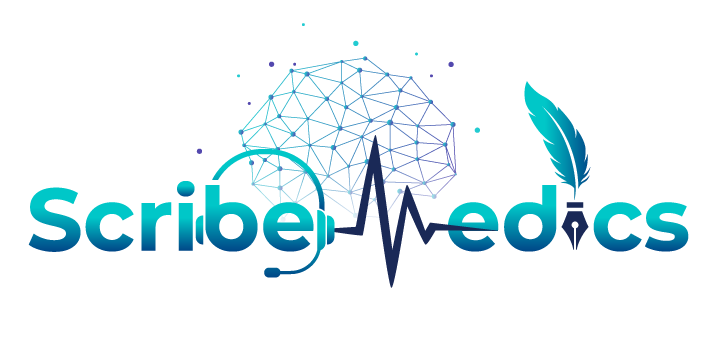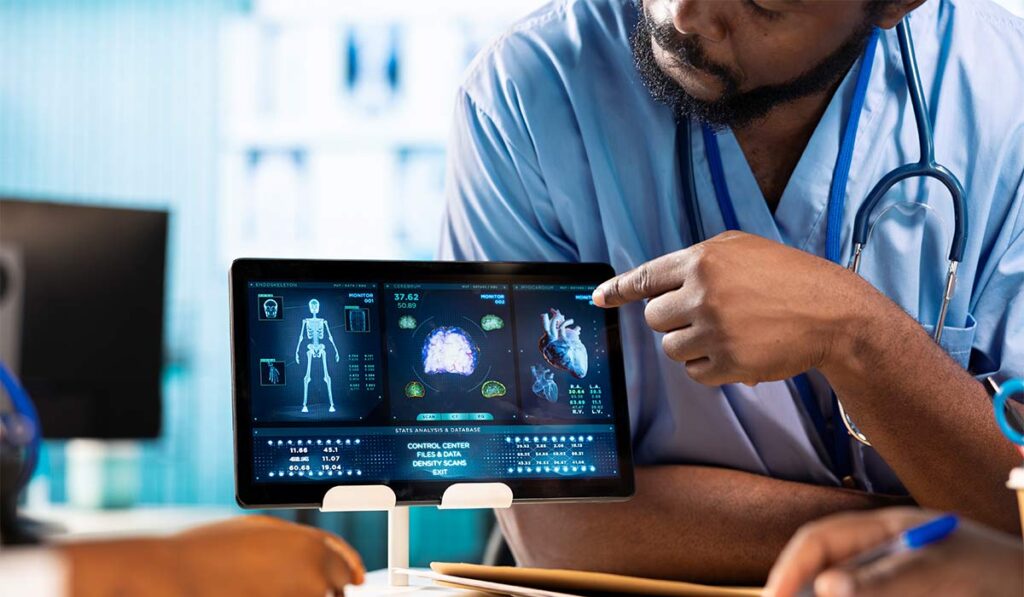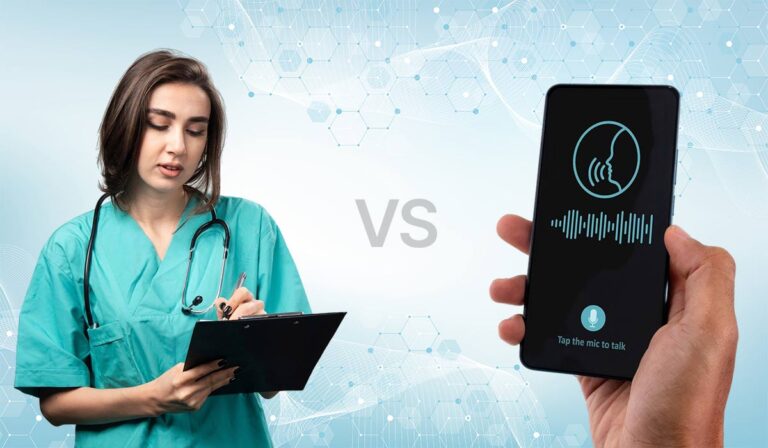Healthcare is changing fast, and so are the demands of doctors, nurses, and surgical staff. In ambulatory surgery centers, clinicians face a big challenge delivering top-quality patient care while staying buried under paperwork and clinical documentation. Every patient visit produces a flood of patient information, from preoperative histories to postoperative instructions. If this data is not captured with precision, mistakes can happen quite often.
This is where AI transcription for ambulatory surgery centers in the United States of America makes a real difference. By using AI tools like ambient AI scribing, AI transcriber solutions, and medical transcription software, surgical teams can transcribe audio into accurate clinical notes in real time. It’s not just about saving time; it’s about improving safety, efficiency, and the overall quality of care.
In this blog, we will explore in detail how AI transcription for outpatient surgery centers is giving new shape to documentation, describe ambulatory surgery, discuss some of the common problems, and demonstrate the way in which AI transcription services are transforming workflows in these fast-paced environments.
What Is Ambulatory Care and Outpatient Surgery?
Ambulatory care refers to healthcare services provided to patients who don’t require an overnight stay in a hospital. It includes routine checkups, diagnostic tests, and minor procedures, usually performed at outpatient clinics or the ambulatory care center. A patient can just walk in, get treated, and walk out on the same day, without hospital admission.
Outpatient surgery, on the other hand, takes place in specialized facilities known as ambulatory surgery centers. These centers provide same-day surgical care, allowing patients to undergo procedures such as cataract removal, hernia repairs, knee arthroscopy, and endoscopies. In outpatient surgery, the patient arrives, undergoes the procedure, and leaves the same day, without requiring an overnight stay in a hospital. This model allows for quicker recovery and less disruption to daily life.
Documentation Challenges in Ambulatory Surgery Centers
Documentation is the key to excellence in an ambulatory surgery center. From consent forms through operative reports to postoperative notes regarding care, it must be completed accurately in order to achieve the best patient care possible. Traditional methods of clinical documentation are plagued by numerous challenges.
Time Drain
The surgeon dedicates hours following patient interactions to keying up clinical notes and entering the information into the EHR system. These documentations are necessary but time-consuming processes and often divert time away from time spent in patient care or well-deserved breaks. This administrative burden is very significant in a busy environment like an ambulatory surgery center, where patient and procedure numbers are high.
Errors
Manual documentation is prone to errors. Manual input will often create incomplete or inaccurate clinical notes with severe impacts on patient treatment. Incorrect documentation has the potential to cause treatment delays, misdiagnosis, or medication administration errors. The issue of always having the correct patient information is highly critical in outpatient surgery since decisions need to be made based on clear and recent information.
Workflow Disruption
Workflow Disruption: Sometimes doctors or surgeons face a difficult choice; they can either focus on the patient during consultations or on typing into the EHR system. Hence, this is disruptive to the flow, with the doctors being forced to divide their attention. Instead of maintaining eye contact with their patients and offering a more compassionate experience, they must divert their focus to typing. This reduces the quality of the interaction and makes it harder to engage with the patient meaningfully.
Compliance Issues
Remaining HIPAA-compliant while handling information of patients manually is a big problem when ambulatory surgery centers often juggle multiple audio files, paper notes, and transcriptions. The risk of losing compliance comes with ensuring that all data is treated securely and that the paperwork is kept up to date. Protecting patient information from unauthorized access and ensuring that it is properly stored and transmitted can become a complicated and error-prone process.
Staff Burnout
Surgeons and medical staff are trained to heal, not to waste hours on clerical work. This large volume of documents for clinical and patient data can result in some form of burnout among medical staff members. This process often builds frustration, and job satisfaction eventually erodes along with productivity. Rather than focusing on their core duties, healthcare providers are bogged down by tedious administrative tasks, leading to increased stress and exhaustion.
The healthcare industry in the USA is now adopting virtual scribe and AI transcription for ambulatory surgery centers, since fast-paced settings require faster and smarter documentation.
What Is AI Transcription?
The process of changing speech into text or recording the clinician-patient interaction into a structured medical document using AI is called AI transcription. It listens to the conversations. and in real time, it converts them into accurate text so that one can read it later. AI transcription services have been designed specifically to work in healthcare environments, properly managing medical terminology and patient data with accuracy. The automation of transcription saves time for healthcare providers and allows better documentation flow; the same data can then be entered into the EHR system so that the patient stays in proper data maintenance.
In the AI transcripts, instant summaries of consultations, operative notes, or discharge instructions are provided for the doctors. It goes against the traditional medical transcription, where everything was manually typed into a computer; today’s AI-driven scribe services use deep learning models and transcribe audio with phenomenal accuracy. Some even integrate directly with the EHR system, automatically filing AI transcripts into the correct patient record, streamlining the documentation process.
Benefits of AI Transcription for Ambulatory Surgery Centers
With today’s increasingly fast-paced healthcare system, particularly in ambulatory surgery centers, time is very vital. With increasing requirements for rapid and quality clinical documentation, the traditional transcription method does not meet the challenges posed by high workloads. And this is where AI transcription for ambulatory surgery centers come to the rescue. These transcription services utilize cutting-edge artificial intelligence to improve workflow and error rate efficiency, enabling healthcare professionals to concentrate on the needs of their patients rather than administration. The following are the advantages that come with using AI transcription at outpatient surgery centers.
1. Faster Documentation
AI text transcriptions can shorten the time of clinical documentation significantly. Surgeons can just speak during or after a visit and within seconds have clinical notes delivered that are ready to review. This transformation allows doctors to save valuable time, which would otherwise be spent typing, enabling them to focus more on their patients and less on administrative tasks.
2. Improved Accuracy
Advanced model-backed AI transcription tools are able to understand difficult medical terminology and context, leading to precise transcription. These systems specialize in understanding speech and transcribing it into accurate, coherent text that is on par with the best human scribes. By reducing the potential for mistakes, AI-driven transcription for outpatient surgery centers helps ensure that every detail of a patient’s care is documented correctly.
3. Reduced Pajama Time
In many cases, doctors in outpatient surgical centers hardly find time during the day to finish their notes, so they stay up late doing them at home: this is what the transcription paradigm calls “pajama time.” With AI, physicians can dictate notes during the day, as they are generated automatically, with less pressure for late-night drafting. This improvement boosts a physician’s quality of life and makes existing medical professionals actually want to rest and recharge.
4. Better Patient Care
When doctors don’t have to spend time typing up lengthy clinical notes, in theory they can instead focus more on their patients. The less time you have to spend on administrative duties, the more hours available for patient care. Surgeons can have eye contact, express empathy, and interact more naturally with patients, improving the overall quality of the healthcare experience.
5. Cost Savings
By replacing manual transcription or outsourcing to human typists, AI transcription services significantly reduce costs. Not only does it save time, but it also eliminates the need to hire additional staff or rely on expensive transcription services. The AI transcription service provides high-quality outputs without the need for extensive human involvement, leading to lower operational expenses.
6. Real-Time Integration
Artificial intelligence has come into the integration of transcription with EHR systems and keeps updating the patient information in real time. This eliminates double entries and misplacement of patient data. AI notes transcriptioning is present inside the EHR system in real time; hence, the clinical documentation is skilled and up-to-date, improving overall efficiency in the workflow.
7. Compliance
The AI transcription services were designed to be HIPAA compliant while managing all information related to the patient population. Protecting sensitive data allowed the services to apply encryption as well as additional measures to ensure data security, thereby meeting strict HIPAA guidelines. This has, in turn, made sure through hospital data management that the patient data is always safe, which helps outpatient surgery centers in staying compliant with healthcare privacy standards.
Traditional vs. AI Transcription: Why the Shift?
The traditional method of transcription in ambulatory surgical centers required a lot of manual labor. After an encounter with a patient, a clinician would seek out a typist to convert the audio recording into written notes, a process that could often take hours or even days to finally complete clinical documentation. This slowed workflows and compromised the accuracy of the documentation. Clinicians were therefore spending more time on paperwork and less time on patient care.
Currently, the AI audio transcription service for ambulatory surgical centers offers almost instant transcription of audio to text with maximum accuracy. Such automation can do away with the handling of multiple outpatient surgical examples, thus making the system very scalable for busy ambulatory surgical centers and outpatient clinics. This ensures uniformity and elimination of errors in clinical notes and patient data entry.
In addition, leading modern AI transcribers have the capability to integrate directly with EHR systems to organize patient details and feed real-time AI transcripts into the correct records. This automation saves time, maintains HIPAA compliance, and allows healthcare providers to focus fully on patient care instead of administrative tasks.
Because of these advantages, such as speed, accuracy, scalability, and automation, more and more ambulatory surgery centers and outpatient surgery centers are shifting to AI transcription services for their daily documentation needs.
Applications of AI Transcription in Ambulatory and Outpatient Settings
In the rapidly paced healthcare environment nowadays, AI transcription services have now changed how ambulatory surgery centers, ambulatory care centers, outpatient clinics, and ambulatory diagnostic centers manage documentation. Given the demand for quick, accurate, and efficient clinical documentation, the traditional manual transcription can no longer keep up. AI transcription automates the process, providing more opportunities for physicians to care for their patients rather than doing paperwork. Let’s take a look at how AI transcription improves workflows and patient outcomes in these places.
Ambulatory Surgery Centers
AI transcription for ambulatory surgery centers improves complex workflows. From pre-op interviews to post-op discharge summaries, all other details are instantly captured by AI tools, cutting the time used for clinical documentation. Surgeons now have more time for patient care and less time for typing, thus creating a more efficient and accurate system.
Ambulatory Care Centers
In ambulatory care centers, AI transcription services record all critical patient information during checkups, blood tests, and scans. Whereas before, doctors used to dictate their notes, which are now transcribed by the AI transcription service instantly into accurate clinical notes, leaving the doctors with more time to interact with the patients.
Outpatient Clinics
In outpatient clinics, AI transcription for outpatient surgery centers makes documenting consultations quicker and more accurate. Clinicians dictate their notes, and AI transcription creates well-organized clinical documentation, reducing errors and improving the quality of care.
Ambulatory Diagnostic Centers
AI transcription in ambulatory diagnostics centers assists doctors in recording test results, lab interpretations, and diagnostic findings in real time. AI transcripts appear instantly, speeding up decision-making and ensuring patient data is accurately documented and integrated into EHR systems
Thus, regardless of setting, AI transcription services take a notable weight off manual work, reduce errors, and allow healthcare providers to channel their energies toward the more important task that is patient care.
The Future of AI Transcription in Ambulatory Care
In ambulatory care, we are still very early in the stage of the AI transcription revolution. As the technology advances, the AI transcription for ambulatory surgery centers and outpatient centers will continue to evolve and bring in greater benefits. The future medical transcription AI will far exceed the capabilities of today, offering a much smarter, faster, and stronger solution to healthcare providers. Here’s a look into the future:
Remote Outpatient Services: AI Video Transcription
AI transcription will extend to AI video transcription for remote consultations and telehealth services. This will enable providers to document clinical information from virtual appointments for real-time use, thereby assuring continuity of care across both in-person and remote appointments, especially in the USA’s growing telemedicine sector.
Real-Time Predictive Alerts for Errors
Advanced AI transcription services will include predictive alerts in real-time that identify errors in clinical notes when they occur. Such a proactive activity would prevent misdiagnoses and enhance documentation accuracy, ultimately leading to greater patient care.
Integration with Billing and Coding Systems
In the future, AI transcription tools will integrate seamlessly with billing and coding systems to ensure that healthcare providers gain compliance and accuracy in medical documentation. This integration will automatically apply codes for the correct procedure, streamlining workflow and reducing administrative overhead.
Smarter AI Transcriptions Across Workflows
The AI transcription will become smarter so that ambulatory surgical centers and outpatient clinics can better handle documentation throughout all workflows. From patient visits to follow-ups, for example, AI will streamline the entire process, reducing errors and improving efficiency.
The future is hybrid. The combination of AI transcriber tools with human oversight will set the new standard for high-quality, accurate transcription. This hybrid model will combine the speed and efficiency of AI with the precision and critical thinking of human review, ensuring the best possible outcomes for patient care. As AI transcription for ambulatory surgery centers continues to evolve, it will help transform USA healthcare into a more efficient, accurate, and patient-centered system.
Conclusion
Healthcare in the United States demands speed, accuracy, and compliance, especially when it comes to ambulatory surgery centers, where the documentation is held to a very high standard. AI transcription for ambulatory surgery centers is the solution to making outpatient surgery safer, faster, and smarter, as it transforms audio-recorded material into highly accurate clinical documentation.
With AI transcription services, ambulatory providers will be able to reduce their paperwork, provide enhanced patient care, and maintain compliance with industry regulations. From outpatient surgery examples to routine ambulatory care, AI transcription is no longer optional; it’s essential.
Doctors should be healing, not typing. With AI transcription services for outpatient surgery centers, doctors may now finally focus on the most important thing: helping patients lead healthier lives. ScribeMedics delivers the best AI transcription services, enabling healthcare professionals to simplify their documentation workflow and provide better patient care.
Frequently Asked Questions
Ambulatory Surgery Centers (ASCs) are specialized medical facilities providing surgical care on the same day, which includes diagnostic and preventive procedures. The centers serve outpatient surgery and ambulatory care in that the patient receives services and is released on the same day. In contrast, inpatient care requires the patient to remain in the hospital for long periods. These centers do very minor and less invasive surgical procedures. Ambulatory surgery centers provide outpatient treatments, allowing the patient to be treated during the day and go home that same day. This kind of setup provides greater convenience to the patient and reduces healthcare costs. In the USA, ambulatory surgery centers are fast becoming a very important component of the healthcare system, as they offer quality yet cheap treatment.
An example of ambulatory surgery is cataract removal. This is a common outpatient surgery where a patient undergoes a procedure to remove the cataract from the eye and replace it with an artificial lens. The surgery takes less than an hour and doesn’t require an overnight stay in the hospital. Patients usually recover in a few hours and can return home the same day. Ambulatory surgery centers handle such procedures efficiently, making them a key part of the healthcare system. Other examples of outpatient surgery include hernia repairs, knee arthroscopy, and endoscopies, all of which are performed in ambulatory care centers.
Another name for ambulatory surgery is outpatient surgery. It denotes a procedure provided to patients who need no hospitalization from day to night. There are solely mild or moderately challenging surgical interventions carried out in facilities called ambulatory surgery centers or outpatient centers. These procedures allow patients to recover at their homes, thereby limiting the lengths of hospital stays and lessening health-related costs. In the USA, the adoption of outpatient surgery has increased in recent years due to advancements in surgical techniques, making it a safer and more convenient option for patients and healthcare providers alike.
In healthcare, AI transcription refers to taking doctor-patient audio interactions and turning them into structured clinical documentation with artificial intelligence. AI audio transcription tools listen to conversations between healthcare providers and patients, transcribing them into text in real time. These AI transcripts help streamline documentation processes in ambulatory surgery centers and outpatient clinics by reducing the time spent manually entering data into EHR systems. The transcription models are trained to recognize medical terminology, ensuring accurate documentation. AI transcription services are crucial for maintaining HIPAA compliance and improving the efficiency and accuracy of medical transcription in healthcare.
AI transcription for ambulatory surgical centers enhances accuracy and efficiency of documentation. With AI transcription services, a surgical team is better equipped to convert audio recordings of patient encounters, surgical procedures, and follow-up instructions into easily organized clinical documentation. The time saved in documentation means more time spent on patient care. Furthermore, an error in patient data capture can be eliminated with the use of AI transcription services. These transcriptions also interface with EHR systems in real-time, providing clinical documentation immediately. Time-wise, these AI transcription services make workflow better, simultaneously boosting the quality of care in ambulatory surgical centers.
Outpatient surgery centers are increasingly adopting AI transcription services to streamline their documentation processes. AI transcription for outpatient surgery centers helps speed up the creation of accurate clinical notes, allowing surgeons and medical staff to spend less time on administrative tasks. With AI tools like AI audio transcription, outpatient surgery centers can transcribe patient encounters and operative reports instantly. This reduces human error, increases productivity, and improves the overall patient experience. Moreover, AI transcription integrates directly with EHR systems, ensuring patient data is correctly stored and easily accessible. This shift to AI transcription ultimately enhances efficiency, accuracy, and compliance.
AI transcription for outpatient surgery centers saves time by automating the process of creating clinical documentation. Instead of spending hours manually typing out operative notes or patient visits, healthcare providers can dictate their observations and have AI transcription tools generate AI transcripts almost instantly. This rapid documentation process significantly reduces pajama time, the late hours spent completing paperwork. AI transcription also integrates seamlessly with EHR systems, eliminating the need for manual entry and reducing the chances of duplication. By cutting down on administrative work, AI transcription services allow surgeons and medical staff to focus more on patient care, improving overall efficiency and productivity.
Dinesh Kumar is a healthcare workflow architect and clinical documentation expert with over a decade of real-world experience supporting physicians across multiple specialties in the United States. As the Co-Founder of ScribeMedics, he has helped transform how medical practices handle documentation, coding, and administrative workflows, reducing burnout, improving patient flow, and enabling clinicians to reclaim their day.
Since 2013, Dinesh has worked closely with providers on the front lines of patient care. Over the years, he witnessed a recurring problem: clinicians were drowning in administrative work, spending hours after clinic hours updating charts, reconciling notes, and managing documentation backlogs. Instead of accepting this as “part of the system,” he decided to fix it.
Under his leadership, ScribeMedics has grown into a global hybrid scribing and documentation support company known for accuracy, compliance, and reliable workflows. From medical scribes and CPC-certified coders to virtual back-office support, his teams help multispecialty practices increase revenue integrity, reduce charting time, and improve patient-physician satisfaction.
Dinesh works with healthcare providers, practice owners, and attorneys who want streamlined documentation, better reimbursement outcomes, and more efficient operations. His approach blends empathy, process engineering, and deep domain expertise to create systems that work, day after day.
When he isn’t optimizing clinical workflows, Dinesh mentors documentation teams, trains young professionals, and speaks about burnout prevention, workflow design, and the future of hybrid AI-driven scribing.









 Medical Transcription
Medical Transcription Medical Billing
Medical Billing Medical Coding
Medical Coding